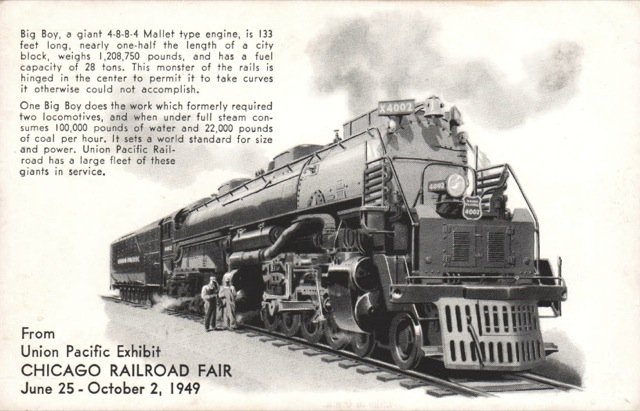Union Pacific Big Boy locomotives rarely, if ever, pulled passenger trains (according to one source they sometimes pulled troop trains), but as one of the largest steam locomotives ever built they proved fascinating to many passengers. Many large steam locomotives, such as the Great Northern 2-8-8-2s (which were rated as more powerful, as measured by tractive effort, than Big Boys), were designed to haul heavy freights at slow speeds of around 20 mph. But the Big Boys were built to go as fast as 80 mph and ordinarily ran at around 40 to 45 mph.

Click image to download a PDF of this postcard.
Aware of the public’s interest in the Big Boys, Union Pacific put one on display at the 1949 Chicago Rail Fair. This postcard’s claim that one Big Boy did the work of two other locomotives is true if the other two are 4-8-4 Northerns, as the Big Boy’s 135,000 pounds of tractive effort is more than twice the 63,000 pounds of tractive effort of UP’s Northerns. However, the Big Boy was only about 40 percent more powerful than a Union Pacific 4-6-6-4 Challenger.
The postcard also says that “when under full steam” the locomotive “consumes 100,000 pounds of water and 22,000 pounds of coal per hour.” Considering that the locomotive’s tender held 28 tons (56,000 pounds) of coal and about 24,000 gallons (200,000 pounds) of water, this limited the locomotive to about two hours of operation at “full steam.” Fortunately, they didn’t run at full steam most of the time. But tests showed that, when pulling a 3,900-ton train up the Wasatch Mountains in Utah, the locomotives used around 10,000 gallons of water and 10 tons of coal per hour, meaning they had to stop for water at least every three hours and coal every five.
Big Boys could have pulled trains from Omaha to Los Angeles, but they were built to haul freights over the mountains of Utah and Wyoming, so they operated almost exclusively in the Cheyenne-Ogden corridor (with occasional side trips to Denver). One Big Boy could do the work of three Diesels, but the Diesels didn’t have to stop for fuel and water several times along the way, so UP retired the locomotives in 1959.
Of the 25 Big Boys built, UP donated eight to various cities and museums. Recently, UP announced it would restore one of them to operation, something most believed would never happen. For one thing, Big Boys burn coal, which is a serious fire hazard, yet an experiment to convert one of them to oil in the late 1940s was unsuccessful. But Union Pacific is a big railroad and generally knows what it is doing. With the 150th anniversary of the Golden Spike ceremony coming up in less than five years, UP apparently wants to be ready.
